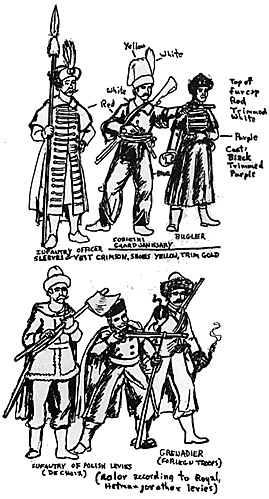The Polish Army of this period included a majority of cavalry. Jean Sobreski had the greatest proportion of infantry of all the Polish Armies of the 17th Century in spite of leaving only one foot soldier for three cavalrymen (1683). This is explained by the fact that (the Polish Army) was forced to guard immense territory against invading horsemen.
The Infantry
The infantry was organized in Independent companies of from 150 to 500 men. Recruiting was various:
 1. Regular Infantry: These had no pikes but handled themselves well with the "Berdis", or ax. Their fire was extremely rapid and deadly. (BVII 2.5.6)
1. Regular Infantry: These had no pikes but handled themselves well with the "Berdis", or ax. Their fire was extremely rapid and deadly. (BVII 2.5.6)
2. Wybraniecka, or "By Choice": (meaning naturally ... Ed.) who were raised by conscription: ten fields were required to provide one soldier. These were the best of Polish infantry. They were uniformed in blue and red (blue coats, red trousers.) the royal colors. Officers, NCOs, and musicians wore red with green and white. The men "of choice" had no pikes and carried the same weapons as the Polano-Hungarian regular Infantry. (BVII 2.5 or 6)
3. Infantry of Foreign Recruitment: These included regiments of German, Scottish, English and Scandanavians in the arms and costumes of those nations, i.e., pikes and western European garb. They also included Polish troops raised on a foreign basis. Towards 1670 this type of Infantry was in the majority, but "Polanization" had reached the officers and the troops, though the maneuvered and formed in western fashion, were dressed as Poles. One knows little of specific uniforms but one must suspect that the colonels had the Kontusy (the large outer robe) distributed to the troops. Note that the Infantry referred to as "Foreign" had by the end of the XVII Century adopted the "Berdis": that weapon of terrible effect in hand to hand combat which inspired such terror among Swedes And Turks. (BVII 1 of 2 above)
4. Infantry of Special Levies: These included the Zaparogues, who in normal times furnished an independent army and had no uniforms as such, nor the Carpathian mountaineers who formed units of Partizans (apparently dressed in brown homespun.)
5. The Guards: Royal
- The Janissaries, of whom there were 500 (BVII red coat)
- The "Trobants", or halbardiers who always followed the king and never fought in the line.
- All groups of cavalry and infantry raised directly by the king wore blue and red.
Of the Hetmen: The Hetmen, like all of the lords, had then living in which they dressed their troops. One knows of that of Radziwill, Grand Hetman of Lithuania: green and red. Thus the Hungarians of the Guard (Hadjuks) wore a green Dolman and Red Trousers, and the Radziwill Janissaries green Kaftans and red trousers. The former wore a bonnet of black felt and the latter a white felt bonnet with a gilded plate in front.
Back to The Armchair General Vol. 2 No. 1 Table of Contents
Back to The Armchair General List of Issues
Back to MagWeb Master Magazine List
© Copyright 1969 by Pat Condray
This article appears in MagWeb (Magazine Web) on the Internet World Wide Web. Other military history articles and gaming articles are available at http://www.magweb.com
